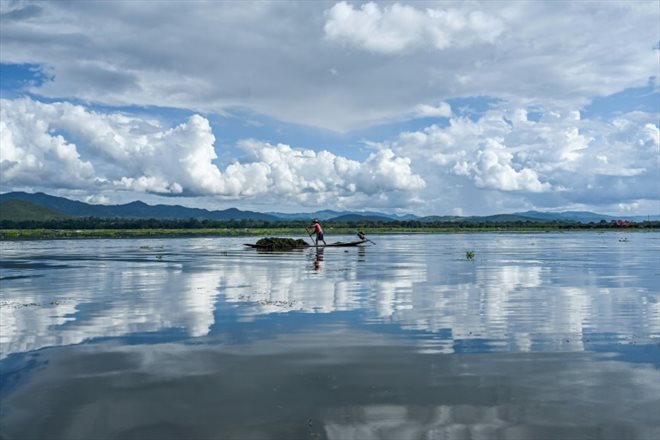A man passes by boat between the rows of his floating farm on Inle Lake, in southern Shan State, on October 17, 2023 in Burma (AFP/SAI AUNG MAIN)
On his wooden boat, Nyunt Win navigates between the rows of his floating vegetable garden to harvest the tomatoes for which Inle Lake is famous, a jewel of biodiversity in Burma.
The natural site, recognized by UNESCO, is home to dozens of floating fields, which grow using a market gardening technique, introduced on site in the 1960s.
The landscape, with the hills of Shan State (north) in the background, attracted thousands of tourists before the 2021 coup.

Women work on a floating farm on Inle Lake, in southern Shan State, on October 17, 2023 in Burma (AFP/SAI AUNG MAIN)
But residents and authorities fear that the uncontrolled development of agriculture will slowly suffocate Inle Lake, with chemical discharges and drifting plant waste eating away at its surface area.
“We are not rich, but it is enough to live on,” assures Nyunt Win, who earns up to 30,000 kyats (14 euros) for around 16 kg of tomatoes.
The crops rest on a bed formed by the accumulation of water hyacinths, supplemented by soil and other components essential for the development of the shoots.
When these assemblages begin to rot, they are left abandoned and harden, contributing to the shrinking of the surface of Inle Lake, whose natural filtering capacities are overwhelmed by the growth of floating agriculture.

Women work on a floating farm on Inle Lake, in southern Shan State, on October 17, 2023 in Burma (AFP/SAI AUNG MAIN)
The surface area of exploited areas increased sixfold between 1992 and 2009, according to data from the Burmese government.
Floating farms are “destroying” the lake, an official from the Ministry of Agriculture, Livestock and Irrigation told AFP, on condition of anonymity.
The authorities do not have the resources to continue their efforts and stem the problem, he explains.
– chemical products –
Farmers like Nyunt Win refute this explanation, and point the finger at their colleagues on the mainland, accused of contributing to the siltation of the site due to decades of slash-and-burn agriculture.

Men collect aquatic vegetation for use on their floating farm, on Inle Lake, southern Shan State, on October 17, 2023 in Burma (AFP/SAI AUNG MAIN)
“When I was young, to reach the bottom of the water I needed a bamboo pole of around 3.50 meters,” explains Nyunt Win.
Now, during the dry summer months, he can pick up “handfuls of dirt” with his bare hands, he describes.
The deterioration of the environment also leads to tensions between farmers and fishermen, due to the extensive use of chemicals which pollute the water.
“When I was a child and I went to school, the water in the lake was not so unhealthy. (…) Now, a lot of fish that were good to eat have disappeared,” says Nay Tun Oo, a 24 year old fisherman.

A man sprays pesticides between the rows of his floating farm, on Inle Lake, in southern Shan State, on October 17, 2023 in Burma (AFP/SAI AUNG MAIN)
A 2017 United Nations report found “considerable overuse” of chemical fertilizers and pesticides to the detriment of the fragile ecosystem that is home to many species of fish and birds.
The increase in nutrients promotes the proliferation of invasive species, underlines this report.
The shrinking lake and environmental concerns could scare away tourists, local entrepreneurs fear.
– “no strangers” –
Inle Lake, recognized since 2015 as a biodiversity reserve by UNESCO, is considered one of the most attractive sites for tourists in Burma.

Fishermen on Inle Lake, in southern Shan State, October 17, 2023 in Burma (AFP/SAI AUNG MAIN)
More than a million Burmese and around 200,000 foreign visitors went there each year before the coronavirus pandemic.
The country has since reopened the borders, but the internal conflict following the February 2021 coup has deterred tourists from coming.
Inle Lake is located in southern Shan State, where clashes broke out at the end of October, near the Chinese border, between the junta and ethnic minority groups.
On site, the population who depended on tourism deplores empty hotels.
“It’s been three years already, and no foreigners come here,” Kyaw Kyaw, 38, who owns a jewelry store, told AFP.

A man collects aquatic vegetation for use in their floating farm, on Inle Lake, southern Shan State, on October 17, 2023 in Burma (AFP/SAI AUNG MAIN)
Some of its employees learn foreign languages in the hope of finding work outside Burma, while others become carpenters.
“We are happy to live here,” says a farmer, Shi Thu Win. But “we are also worried about the lake which is disappearing.”
© 2023 AFP
Did you like this article ? Share it with your friends using the buttons below.




